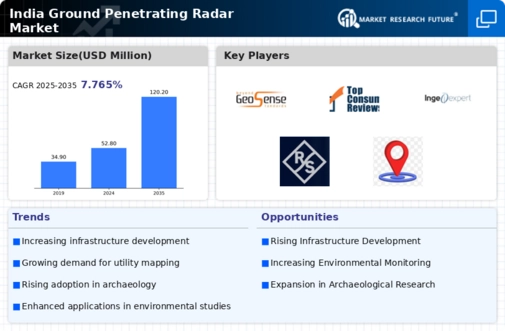Emerging Environmental Concerns
Environmental issues in India, such as soil contamination and groundwater depletion, are increasingly driving the ground penetrating-radar market. The technology is instrumental in assessing subsurface conditions, identifying contamination sources, and monitoring environmental changes. With stricter regulations on environmental protection, industries are compelled to adopt non-destructive testing methods to comply with legal standards. The Indian government has implemented various policies aimed at environmental conservation, which has led to a heightened focus on sustainable practices. As organizations seek to mitigate environmental risks, the demand for ground penetrating radar is expected to rise. This trend indicates a shift towards more responsible environmental management, positioning the ground penetrating-radar market as a critical tool in addressing ecological challenges.
Increased Infrastructure Development
The rapid pace of infrastructure development in India is a primary driver for the ground penetrating-radar market. With the government investing heavily in projects such as roads, bridges, and urban development, the need for effective subsurface investigation has surged. Ground penetrating radar technology offers a non-invasive method to assess soil conditions and locate underground utilities, which is crucial for minimizing disruptions during construction. In 2023, the Indian government allocated approximately $15 billion for infrastructure projects, indicating a robust growth trajectory. This investment not only enhances the demand for ground penetrating radar but also encourages construction firms to adopt advanced technologies for efficient project execution. As urbanization continues to rise, the ground penetrating-radar market is likely to experience significant growth, driven by the necessity for accurate subsurface mapping in various infrastructure initiatives.
Growing Investment in Mining Exploration
The mining sector in India is witnessing a resurgence, driven by increasing demand for minerals and resources. This growth is propelling the ground penetrating-radar market, as mining companies require advanced technologies to explore and assess mineral deposits. Ground penetrating radar provides critical insights into subsurface geology, enabling more efficient exploration and reducing the risks associated with mining operations. In 2023, the Indian mining industry was valued at approximately $50 billion, with expectations of continued growth. As companies seek to optimize their exploration efforts and minimize environmental impact, the adoption of ground penetrating radar is likely to rise. This trend indicates a robust future for the ground penetrating-radar market, as it becomes an essential tool for the mining sector in India.
Rising Demand for Archaeological Surveys
India's rich cultural heritage and archaeological sites have led to an increased demand for ground penetrating-radar technology in archaeological surveys. The ability to non-invasively explore subsurface structures without disturbing the ground is invaluable for archaeologists. Ground penetrating radar can reveal hidden artifacts and ancient structures, thus preserving historical sites while facilitating research. In recent years, several archaeological projects have been initiated across the country, with funding from both governmental and non-governmental organizations. This trend suggests a growing recognition of the importance of preserving cultural heritage, which in turn fuels the ground penetrating-radar market. As more archaeological sites are discovered and explored, the need for advanced surveying techniques will likely expand, further driving market growth in this sector.
Technological Integration in Construction
The integration of advanced technologies in the construction sector is significantly influencing the ground penetrating-radar market. As construction firms increasingly adopt digital tools such as Building Information Modeling (BIM) and Geographic Information Systems (GIS), the need for accurate subsurface data becomes paramount. Ground penetrating radar complements these technologies by providing precise information about underground conditions, which is essential for effective planning and execution. The construction industry in India is projected to grow at a CAGR of 7.1% from 2023 to 2028, further amplifying the demand for innovative solutions. This integration not only enhances project efficiency but also reduces costs associated with unforeseen subsurface issues. Consequently, the ground penetrating-radar market is likely to benefit from this trend as construction companies seek to leverage technology for improved outcomes.















Leave a Comment